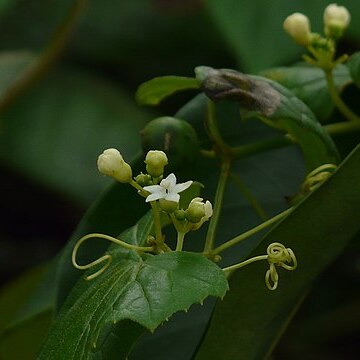Perennial herb. Stems to 6 m, almost glabrous or sparsely to densely shortly crispate-pubescent or setulose, prostrate or scandent. Leaf-lamina 1·9-11 x 2-11 cm, membraneous to subcoriaceous, ovate or broadly ovate in outline, deeply cordate to subtruncate at the base, deep green and scabrid-punctate above, paler and sparsely setulose to densely cinereous-velutinous on the veins beneath, obscurely and remotely to prominently sinuate-denticulate at the margins, unlobed or sometimes palmately 3-5-lobed, the lobes broadly triangular to ovate or elliptic, the central largest, shortly acuminate, obtuse to acute, apiculate, the lateral shorter. Petioles 0·7-7·0 cm long, glabrous to densely antrorsely setulose or crispate-pubescent. Flowers dioecious. Male flowers 3-60 or more in dense subumbelliform or shortly racemiform sessile or pedunculate axillary clusters, usually co-axillary with a long-pedicellate solitary flower, rarely solitary; peduncles 0·9-7 cm long; pedicels 1·5-10 mm long. Receptacle-tube 2·0-5·5 mm long, pale green; lobes 0·2-1·5 mm long, dentiform. Petals 1·5-3·5 mm long, white, becoming yellowish with age; stamens 3. Female flowers solitary or 2-10 or more in subumbelliform sessile or pedunculate axillary clusters; peduncles up to 2·7 cm long; pedicels 0·4-11(20) mm long; ovary 2·5-5 mm long, ellipsoid, rostrate, glabrous or shortly pubescent. Fruits 1-10 or more in axillary clusters, bright red, usually glabrous, globose, 8-13 mm in diameter, or ellipsoid, 10-12 x 7-8 mm; pedicels 2-68 mm long. Seeds 2·0-5·6 x 1·1-4·5 x 0·4-1 mm, ovate in outline, smooth, compressed.
Leaf-lamina 1·9–11 × 2–11 cm., membraneous to subcoriaceous, ovate or broadly ovate in outline, deeply cordate to subtruncate at the base, deep green and scabrid-punctate above, paler and sparsely setulose to densely cinereous-velutinous on the veins beneath, obscurely and remotely to prominently sinuate-denticulate at the margins, unlobed or sometimes palmately 3–5-lobed, the lobes broadly triangular to ovate or elliptic, the central largest, shortly acuminate, obtuse to acute, apiculate, the lateral shorter.
male flowers 3–60 or more in dense subumbelliform or shortly racemiform sessile or pedunculate axillary clusters, usually co-axillary with a long-pedicellate solitary flower, rarely solitary; peduncles 0·9–7 cm. long; pedicels 1·5–10 mm. long. Receptacle-tube 2·0–5·5 mm. long, pale green; lobes 0·2–1·5 mm. long, dentiform. Petals 1·5–3·5 mm. long, white, becoming yellowish with age; stamens 3.
Female flowers solitary or 2–10 or more in subumbelliform sessile or pedunculate axillary clusters; peduncles up to 2·7 cm. long; pedicels 0·4–11(20) mm. long; ovary 2·5–5 mm. long, ellipsoid, rostrate, glabrous or shortly pubescent.
A herb. It is a pumpkin family plant. It is a climber. It keeps growing from year to year. The leaves are heart shaped and have sharp teeth along the edges. The fruit are round or oval and change from green to yellow or red.
Dioecious, glabrescent, perennial climber to 6 m. Leaves cordate, toothed, rough above and softly hairy below. Flowers in axillary umbels, cream-coloured. Fruits fleshy, scarlet.
Fruits 1–10 or more in axillary clusters, bright red, usually glabrous, globose, 8–13 mm. in diameter, or ellipsoid, 10–12 × 7–8 mm.; pedicels 2–68 mm. long.
Stems to 6 m., almost glabrous or sparsely to densely shortly crispate-pubescent or setulose, prostrate or scandent.
Petioles 0·7–7·0 cm. long, glabrous to densely antrorsely setulose or crispate-pubescent.
Seeds 2·0–5·6 × 1·1–4·5 × 0·4–1 mm., ovate in outline, smooth, compressed.
Flowers dioecious.

